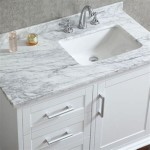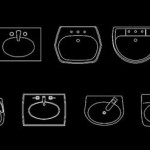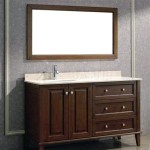Removing a Bathroom Mixer Tap Handle
Mixer taps provide a convenient way to control both hot and cold water flow within a single unit. Over time, however, the handles may become stiff, leaky, or aesthetically worn, requiring removal for repair or replacement. This article outlines the process for removing a variety of bathroom mixer tap handles.
Essential Tools and Materials
Before commencing any work, gather the necessary tools. Having everything at hand streamlines the process and prevents interruptions. The following items are typically required:
- Flathead screwdriver or Allen key (depending on the tap design)
- Adjustable wrench
- Penetrating oil (WD-40 or similar)
- Cloth or rag
- Safety glasses (recommended)
Identifying the Tap Handle Type
Mixer tap handles vary in design. Identifying the type of handle dictates the appropriate removal method. Common types include:
- Screw-fixed handles: These handles are secured with a small grub screw, often hidden beneath a decorative cap.
- Lever handles: These handles are usually affixed with a small Allen key screw, similarly concealed under a cap.
- Push-fit handles: Less common, these handles are pressed onto the valve spindle and may require a specialized tool for removal.
Removing Screw-fixed Handles
This is the most common type of mixer tap handle. The removal process involves the following steps:
- Locate the grub screw: This is typically found on the underside or side of the handle, often concealed by a small cap. Carefully pry off the cap using a flathead screwdriver.
- Loosen the grub screw: Use the appropriate sized Allen key or flathead screwdriver to loosen the grub screw. Do not completely remove the screw.
- Remove the handle: Once the grub screw is loose, the handle should pull straight off the valve spindle. If the handle is stiff, gentle rocking may be necessary.
Removing Lever Handles
Lever handles are also commonly found on modern mixer taps. The removal process is similar to screw-fixed handles, with a few key differences:
- Locate the Allen key screw: As with screw-fixed handles, the Allen key screw is often concealed beneath a decorative cap.
- Loosen the Allen key screw: Use the correct sized Allen key to loosen the screw. Again, do not completely remove the screw.
- Remove the handle: The lever handle should now slide off the valve spindle. Gentle wiggling or rocking may assist if the handle is stuck.
Removing Push-fit Handles
Push-fit handles are less common and may require a specialized tool depending on the manufacturer. Proceed with caution and consult the manufacturer's instructions if available.
- Inspect the handle: Look for any visible clips or release mechanisms.
- Use a handle puller: If a specific tool is required, a handle puller can be used to evenly distribute force and avoid damaging the handle or tap body. These can often be purchased from plumbing supply stores.
- Apply penetrating oil: If the handle is particularly resistant, applying penetrating oil around the base can help loosen it.
Dealing with Stubborn Handles
If a handle refuses to budge, avoid excessive force which could damage the tap. The following techniques can help:
- Apply penetrating oil: Spray penetrating oil around the base of the handle and allow it to soak for a few minutes. This can help loosen mineral deposits or corrosion.
- Heat application: Carefully apply heat using a hairdryer to the base of the stuck handle. The heat can help expand the metal and loosen the grip. Avoid using an open flame.
- Seek professional help: If the handle remains stubbornly fixed, it's advisable to contact a qualified plumber to avoid causing further damage.
Protecting the Tap Finish
Protecting the tap finish throughout the removal process is crucial. Take the following precautions:
- Use a soft cloth: Place a soft cloth between the wrench and the tap body to prevent scratching the finish when applying torque.
- Avoid excessive force: Excessive force can damage the tap finish or internal components.
- Clean up any spills: Clean up any spilled penetrating oil immediately to prevent damage to the tap finish.
Inspecting the Valve and Components
Once the handle is removed, take the opportunity to inspect the valve and other components for wear and tear. This is a good time to replace any worn-out parts, such as O-rings or cartridges, to prevent future issues.
- Check for leaks: Look for any signs of water leakage around the valve or spindle.
- Inspect O-rings: Examine the O-rings for cracks or damage. Replace them if necessary.
- Check the cartridge: If the tap is still leaking after replacing the O-rings, the cartridge may need replacement.

How To Remove Mixer Tap Handle Bunnings Work Community

Single Lever Mono Basin Flow Cartridge Maintenance And Replacement

How To Remove A Less Faucet Tap Without Vandal Proof Spanner

Removing Stuck Handle From Faucet Mixer Tap Doityourself Com Community Forums

Removing Stuck Handle From Faucet Mixer Tap Doityourself Com Community Forums

Fixing A Stiff Or Leaking Mixer Tap Cartridge Removal And Disassembly

How To Replace A Lever Tap

Tap Magician Removing Diffe Types Of Handles Heads Replacing Ceramic Cartridge Valve

Replacing A Cartridge In Mixer Tap The

Learn The 7 Diy Steps To Replace Your Tap Washer Blog
Related Posts







